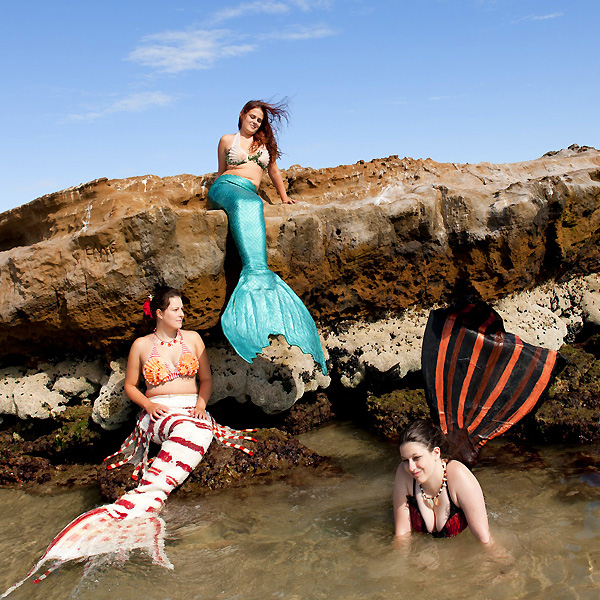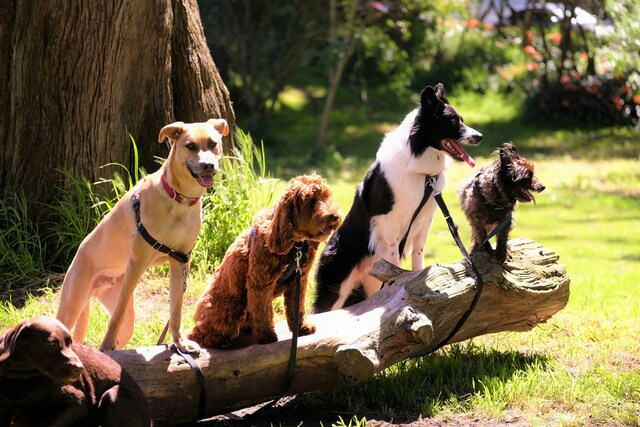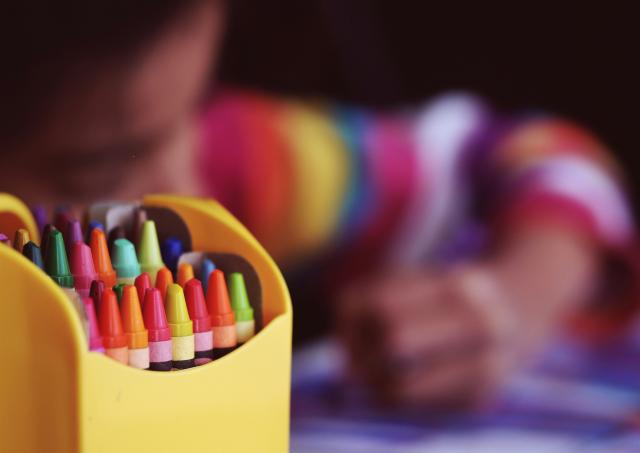The global “mermaiding” trend is making a splash in Melbourne.
A GORGEOUS woman with long blonde hair dives through the water, a shimmering fish tail propelling her powerfully through the sea. She emerges into the sunlight, her golden tresses cascading down her shoulders.
When most of us think of mermaids, we think of the flaxen-haired beauty Daryl Hannah from the 1980s movie Splash, or the button-nosed Ariel from Disney’s The Little Mermaid.
But for some, there’s more to mermaids than fairytales and Hollywood.
Take Katie Dawson from Mordialloc. By day she’s a science student at Monash University but when she’s not poring over her books, chances are you’ll find her frolicking in the waves at Mentone Beach sporting a red and white striped mermaid’s tail.
Like her friends, Shelly Dunlop, 21, from Doncaster East and Katie Laczko, 22, from Croydon, Dawson is a self-described mermaid. The trio, who go by the mermaid names Nerissa, Aradia and Volitania, devote their downtime to sewing human-size fish tails and crafting clam shell bikini tops, ready for a day of frolicking at Bayside beaches or the Glen Waverley pool, or performing at children’s parties.
What they love most, however, is advocating for the well-being of marine creatures and their environment.
Contrary to what some may think, they insist they’re not dressing up for erotic or sexual reasons, but rather sharing their conservation message at Clean Up Australia Day events, beach cleaning sessions and even university orientation week events.
They are not alone. The friends are part of the burgeoning social phenomenon of ‘‘mermaiding’’. Around the world, increasing numbers of mere mortals are donning tails as professional entertainers, models, actors or marine conservationists.
Melbourne mermaids are still a rarity. Perhaps not surprisingly, most self-described mermaids live in warmer, more splash-friendly climes.
Hannah “Mermaid” Fraser, who graduated from Eltham High School in the early 1990s before studying graphic design at Swinburne University in the mid ’90s, now lives in Byron Bay, where she makes a living as a mermaid model. Not just a pretty face, Hannah uses her fabulous fins for good, not evil. Married to pro-surfer Dave Rastovich, the couple once organised a group paddle into Japanese waters to protest against dolphin slaughter.
Fellow Byron resident Kazzie Mahina, also known as Mahina Mermaid, heads south to Melbourne regularly to perform at the Melbourne Aquarium, to swim with the sharks and to promote her range of eco-friendly children’s mermaid outfits under the name Oceanika MerFins, which she describes as the first functional rubber mermaid fin of its kind on the market.
She works as a ‘‘mer-model’’ and offers her services for photo shoots or special events, as does her own “merman” Max, who wears a whale fin. The pair is working on their own “merbaby”.
On top of her regular commercial modelling gigs, Mahina also does shoots to help raise awareness of dolphin and whale slaughter.
She says mermaiding is a way of giving a voice to the ocean. ‘‘All of the stuff I do is about ocean conservation. We do beach clean-ups and I work with ocean conservation groups, so my fins are really about that message and teaching kids to be little ocean custodians. The ocean doesn’t have a voice, so the mermaid can speak for it.”
She says the mermaiding craze is taking over from the vampire fashion that has gripped pop culture for the past few years. ‘‘I think it’s time for it,” she says. “It’s about locking into the life force of nature – the sensitivity of nature, the fragility, the beauty. The water keeps everything alive and flourishing. Without the help of our water we’re all in big trouble.”
She says although Melbourne hasn’t embraced mermaiding culture in the same way as warmer parts of Australia, that is slowly changing.
“That’s my mission, that’s why I developed the MerFins. My passion is spreading mermaiding and making it accessible for people everywhere.”
While dressing up as a mermaid for kicks, to make some money or to raise awareness of marine conservation is a reasonably new trend – it took off about 10 years ago, mainly in the US – the folklore of mermaids certainly isn’t. Mermaids were around long before Hans Christian Andersen published The Little Mermaid in 1836.
The first tales of aquatic creatures with the head and arms of a woman and the tail of a fish appeared about 1000BC in Assyria, in an area that would now be part of Iraq. According to the mythology, a goddess accidentally killed her lover and jumped into the sea in the hope of becoming a fish. The sea was unable to hide her incredible beauty, and she was stuck being half-fish, half very attractive woman. Greek legends also tell of these sexy and yet tragic figures.
Eventually mermaid stories spread around the world, across the Middle East to Europe and Asia. Sailors and explorers including Christopher Columbus and Henry Hudson claimed to see mermaids during their voyages. Modern-day theorists believe these ‘‘mermaids’’ were almost certainly dugongs, sometimes called ‘‘sea cows’’.
It seems mermaids have never left the popular imagination. Even today, UK magazine Mermaids & Mythology pays homage to these legendary sea creatures, and Australian teen drama H2O: Just Add Water, which screened on the Disney Channel, offers a fun look at what it would be like to be a Gold Coast mermaid. And the delightful 2008 Japanese animation Ponyo explores the innocence of childhood and the magic of an ocean merbaby.
In Las Vegas, Silverton Hotel holds an international mermaid pageant. The resort has a 442,000-litre reef aquarium, complete with stingrays, sharks and tropical fish, and a resident mermaid who swims between Thursdays and Sundays.
Perhaps not surprisingly, Lady Gaga has jumped on the bandwagon, recently introducing her mermaid alter ego Yuyi, while pop babe Katy Perry has also been known to attach a tail.
University of Melbourne researcher Dr Michelle Smith, who studies girls’ literature and popular culture, likens the mermaiding trend to the penchant for dressing up as a vampire to ‘‘live out a fantasy of something that never was’’.
‘‘It’s a little subculture of role-playing, but it’s not just about the look and the posing, they’re very much into the mythology,’’ she says. ‘‘It’s also a little like pin-up culture – ordinary women can feel like they’re a pin-up too, so the photos and videos are important. It’s about having that photoshoot to show other people.’’
But Melbourne mermaid Katie Laczko says she’s more interested in focussing the attention she receives on positive things such as water conservation, water safety and sun protection.
A keen scuba diver and secretary of the Monash Underwater Club, she takes people on tours of Port Phillip Bay, delighting in opening others’ eyes to the vibrant and varied ecosystem on our doorstop.
“If I’m talking as a diver it’s a lot less interesting, it’s a lot less entertaining, whereas when I’m a mermaid, children hang on to my every word,” she says.
While she has a healthy respect for mermaids of the Splash variety, she says she was always much more inspired by Disney’s Ariel. “We’re a lot less about looking pretty and falling in love with guys. We’re active and doing things,” she says.
Laczko and her friends have been mermaiding for about two years, creating their elaborate tails out of neoprene, latex, silicon and spandex. Dunlop had a childhood obsession with The Little Mermaid. “It occurred to me mermaids wouldn’t be able to walk, so I dragged myself around the house,” she says.
She says it’s almost impossible to move when out of the water while wearing her tail. But the biggest hazards for the modern-day mermaid, she says, are shin scrapes, muscle cramps and overexcited children who want to “ride the mermaid”.
“When we’re doing kids’ parties, we always make sure there’s some kind of support around,” she says.
While most people are delighted when they chance upon a mermaid on the beach, and are only too keen to come up and ask for photos, Dawson says she has been surprised by some people’s negative reactions when they see mermaids on television or in the media.
“In person, people are usually very positive, but as soon as you get a few degrees of separation, people think we’re weird,” she says.
While her hobby may seem a little unusual, Dawson insists it’s as valid as any other pastime. “We could go to the pub every Friday night or we could go to the beach and have fun.”







